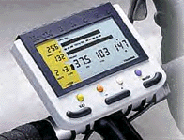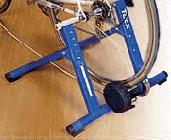Turbo trainers
There are many turbo trainers on the market and as with any cycle equipment you can buy quality or rubbish, so beware. Look for a turbo trainer  that is well made, of good quality materials and well finished. Tacx and Elite are both excellent brands and if you can afford a trainer that is programmable (see left) then do so, as these help reduce boredom even more.
that is well made, of good quality materials and well finished. Tacx and Elite are both excellent brands and if you can afford a trainer that is programmable (see left) then do so, as these help reduce boredom even more.
For a selection of Turbo trainers click the link.
The bike
Ideally you will also need an old bike, or your training bike with the same riding position as your racing bike. It is not advisable to use your best bike for turbo training as it can be subjected to frame stress and sweat is pretty corrosive, and boy will you sweat. If you have to use your racing bike and I know many who do. I've found that a strategically placed towel, combined with a frame and components protected with cycle polish, afford effective protection to your bike. 
Other equipment
As you will sweat a lot, an electric fan is a good investment. Another item of equipment is a large ish clock. Many riders rely on their wrist watch or heart rate monitor for the timing, but there are times when the effort that you are making can make it difficult for you to read a small watch face quickly. A large-faced clock with a second hand can be bought quite cheaply and is well worth the outlay.
Another desirable, but not truly essential item is a heart monitor. However with prices starting from as little as £35 for a basic model they are a worthwhile investment and it will help you to get more from your turbo training sessions.
As a personal aside I would strongly suggest that anyone serious about their training should invest in a heart rate monitor and arguably the best on the market are from POLAR. For a wide selection of the best heart rate monitors from POLAR, click the name.